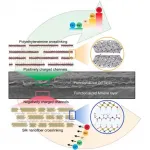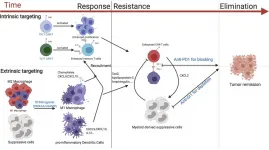(Press-News.org) December 30, 2020 - As the COVID-19 pandemic emerged, trauma centers faced unprecedented obstacles to providing care for injured patients. A look at steps taken by trauma centers in response to COVID-19 is provided by a survey in the January/February Journal for Healthcare Quality (JHQ), the peer-reviewed journal of the National Association for Healthcare Quality (NAHQ). The journal is published in the Lippincott portfolio by Wolters Kluwer.
Trauma centers introduced new processes to optimize use of personal protective equipment (PPE), ICU beds, ventilators, and other limited resources, according to the report by David Bar-Or, MD, of ION Research, Englewood, Colo., and colleagues. "This information will be of value as trauma centers continue to respond and adapt to the pandemic, focusing on meeting the need for critical trauma services while protecting the health of trauma care teams," Dr. Bar-Or comments.
New processes to provide care at U.S. trauma centers, despite scarce resources
As the pandemic took hold in the spring of 2020, hospitals struggled to provide care not only for patients with COVID-19, but also for other groups of patients in need of care that couldn't be delayed. While the American College of Surgeons Committee on Trauma provided initial guidance on maintaining trauma center access, it was up to individual trauma centers to work out detailed processes for providing patient care.
"Trauma centers have a unique situation in that admissions for traumatic injuries are not scheduled and therefore cannot be cancelled or postponed," Dr. Bar-Or and colleagues point out. "Accordingly, they must prepare for an influx of patients with acute respiratory symptoms and continue care for patients with traumatic injuries."
To gain insights into how they met these challenges, Dr. Bar-Or and colleagues surveyed directors of six level I trauma centers in four states: Colorado, Kansas, Missouri, and Texas. The responses provided insights into changes in key areas, including:
N-95 respirators. Trauma centers faced shortages of essential N-95 respirator masks. Four of the six trauma centers surveyed reported reusing respirators after employing various methods of sanitization or sterilization. At some centers, trauma team members received only one mask per day or per week.
PPE. Most trauma centers clustered patient contacts, with the aim of minimizing need for personal protective equipment (masks, gowns, respirators, etc). Four hospitals increased PPE use for all patients on arrival, while two provided PPE to symptomatic patients. One hospital had to request PPE from local government due to regional shortages.
ICU beds. Five hospitals added ICU beds, while three designated a specific ICU for COVID-19 patients. All hospitals isolated COVID-19 patients in negative pressure rooms. In some cases, rooms or entire floors were converted to negative pressure.
Mechanical ventilation. Two trauma centers created ventilator allocation protocols. Three centers reported daily tracking of ventilator use, while three requested additional ventilators in anticipation of a surge. The trauma centers reported varying changes to intubation protocols, and in the use of noninvasive ventilation approaches (CPAP or BiPAP).
The survey was conducted in the latter half of May 2020, as U.S. Coronavirus deaths passed the 100,000 mark. At that time, none of the trauma centers had experienced an overwhelming surge of COVID-19 patients. "This could be due to the actions taken to allow for additional treatment beds," the researchers write.
The survey provides a snapshot of how trauma teams and hospitals met the need for essential trauma care through the first months of the Coronavirus crisis. "This study summarized the processes that participating trauma centers developed to protect the trauma patient and trauma care providers while providing optimal trauma care for patients--without specific guidance from professional organizations," Dr. Bar-Or and colleagues conclude. "This was possible even when faced with scarce resources."
INFORMATION:
Click here to read "Processes for Trauma Care at Six Level I Trauma Centers During the COVID-19 Pandemic."
DOI: 10.1097/JHQ.0000000000000285
About the Journal for Healthcare Quality
The Journal for Healthcare Quality (JHQ), a peer-reviewed journal, is an official publication of the National Association for Healthcare Quality. (NAHQ). JHQ is a professional forum that continuously advances healthcare quality practice in diverse and changing environments, and is the first choice for creative and scientific solutions in the pursuit of healthcare quality. The Journal publishes scholarly articles that are targeted to leaders of all healthcare settings, leveraging applied research and producing practical, timely and impactful evidence in healthcare system transformation.
About NAHQ
NAHQ is the leader in healthcare quality competencies. NAHQ provides a strategic advantage to healthcare professionals and the organizations they serve by developing and evolving competencies in healthcare quality that result in better patient and financial outcomes to support the goals of healthcare value. NAHQ offers the industry standard certification in healthcare quality, extensive educational programming, networking opportunities, and career resources to help healthcare professionals meet the challenges they face. Learn more about NAHQ at nahq.org.
About Wolters Kluwer
Wolters Kluwer (WKL) is a global leader in professional information, software solutions, and services for the clinicians, nurses, accountants, lawyers, and tax, finance, audit, risk, compliance, and regulatory sectors. We help our customers make critical decisions every day by providing expert solutions that combine deep domain knowledge with advanced technology and services.
Wolters Kluwer reported 2019 annual revenues of €4.6 billion. The group serves customers in over 180 countries, maintains operations in over 40 countries, and employs approximately 19,000 people worldwide. The company is headquartered in Alphen aan den Rijn, the Netherlands.
Wolters Kluwer provides trusted clinical technology and evidence-based solutions that engage clinicians, patients, researchers and students with advanced clinical decision support, learning and research and clinical intelligence. For more information about our solutions, visit https://www.wolterskluwer.com/en/health and follow us on LinkedIn and Twitter @WKHealth.
For more information, visit http://www.wolterskluwer.com, follow us on Twitter, Facebook, LinkedIn, and YouTube.
WHAT:
The investigational vaccine known as mRNA-1273 was 94.1% efficacious in preventing symptomatic coronavirus disease 2019 (COVID-19), according to preliminary results from a Phase 3 clinical trial reported in the New England Journal of Medicine. The vaccine also demonstrated efficacy in preventing severe COVID-19. Investigators identified no safety concerns and no evidence of vaccine-associated enhanced respiratory disease (VAERD).
The vaccine was co-developed by Moderna, Inc., a biotechnology company based in Cambridge, Massachusetts, and the National Institute of Allergy and Infectious Diseases (NIAID), part of the National Institutes ...
"Today's computer applications generate a large amount of data that needs to be processed by machine learning algorithms," says Yeseong Kim of Daegu Gyeongbuk Institute of Science and Technology (DGIST), who led the effort.
Powerful 'unsupervised' machine learning involves training an algorithm to recognize patterns in large datasets without providing labelled examples for comparison. One popular approach is a clustering algorithm, which groups similar data into different classes. These algorithms are used for a wide variety of data analyses, such as identifying fake news on social media, filtering spam in our e-mails, and detecting ...
DALLAS - Dec. 30, 2020 - When fat cells in the body are stuffed with excess fat, the surrounding tissue becomes inflamed. That chronic, low-level inflammation is one of the driving factors behind many of the diseases associated with obesity. Now, UT Southwestern scientists have discovered a type of cell responsible, at least in mice, for triggering this inflammation in fat tissue. Their findings, published in Nature Metabolism, could eventually lead to new ways to treat obesity.
"The inflammation of fat cells in obese individuals is linked to many of the ...
Lithium is an energy-critical element that is considered to be a geopolitically significant resource. However, the supply of lithium may not be enough to meet continuously increasing demand. As a result, scientists are looking for new ways to extract lithium ions.
Ion selective membranes have already been used extensively for water treatment and ion sieving in electrodialysis technology. However, conventional membranes exhibit low and useless Li+ selectivity, making them insufficient for meeting industry requirements.
Chinese scientists have recently made progress in the preparation and application of a bioinspired ...
Arctic sea ice has been rapidly declining in recent decades, and changes in arctic sea ice can have a significant impact on global weather and climate through interactions with the atmosphere and oceans. In addition, the Arctic shipping routes are a shortcut to connect the major countries in the Northern Hemisphere. The Arctic region is also rich in natural resources and biological resources. Simulation of the Arctic sea ice could provide valuable information for Arctic shipping as well as climate studies, and it is therefore urgent to evaluate the ability to simulate Arctic sea ice and diagnose the sources of simulation errors.
To address the issue of error source identification, ...
Experts in optical physics have developed a new way to see inside living cells in greater detail using existing microscopy technology and without needing to add stains or fluorescent dyes.
Since individual cells are almost translucent, microscope cameras must detect extremely subtle differences in the light passing through parts of the cell. Those differences are known as the phase of the light. Camera image sensors are limited by what amount of light phase difference they can detect, referred to as dynamic range.
"To see greater detail using the same image sensor, we must expand the dynamic range so that we can ...
Activating an immune signaling pathway best known for fighting viral and bacterial infections can boost the ability of genetically engineered T cells to eradicate breast cancer in mice, according to a new study by researchers at the University of North Carolina. The study, to be published December 31 in the Journal of Experimental Medicine (JEM), suggests that CAR T cells, which are already used to treat certain blood cancers in humans, may also be successful against solid tumors if combined with other immunotherapeutic approaches.
Chimeric antigen receptor (CAR) T cells are a type of white blood cell that have been genetically engineered to recognize ...
The Asian tiger mosquito does not pose a major risk for Zika virus epidemics, according to a study published December 31 in the open-access journal PLOS Pathogens by Albin Fontaine of the Institut de Recherche Biomédicale des Armées, and colleagues.
Zika virus has triggered large outbreaks in human populations, in some cases causing congenital deformities, fetal loss, or neurological problems in adults. While the yellow fever mosquito Aedes aegypti is considered the primary vector of Zika ...
A novel computational drug screening strategy combined with lab experiments suggest that pralatrexate, a chemotherapy medication originally developed to treat lymphoma, could potentially be repurposed to treat Covid-19. Haiping Zhang of the Shenzhen Institutes of Advanced Technology in Shenzhen, China, and colleagues present these findings in the open-access journal PLOS Computational Biology.
With the Covid-19 pandemic causing illness and death worldwide, better treatments are urgently needed. One shortcut could be to repurpose existing drugs that were originally developed to ...
Multiple bouts of blood feeding by mosquitoes shorten the incubation period for malaria parasites and increase malaria transmission potential, according to a study published December 31 in the open-access journal PLOS Pathogens by Lauren Childs of Virginia Tech, Flaminia Catteruccia of the Harvard T.H. Chan School of Public Health, and colleagues. Given that mosquitoes feed on blood multiple times in natural settings, the results suggest that malaria elimination may be substantially more challenging than suggested by previous experiments, which typically involve a single blood meal.
Malaria ...









